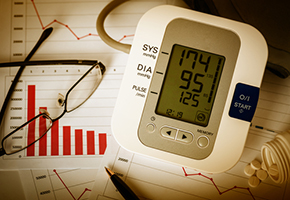 A study of more than 4 million people in the U.K. found that those with high blood pressure were almost 60% more likely to develop type 2 diabetes than people with normal blood pressure.
A study of more than 4 million people in the U.K. found that those with high blood pressure were almost 60% more likely to develop type 2 diabetes than people with normal blood pressure.
But why is that?
In fact, the key to cure both type 2 diabetes and high blood pressure naturally may lie in understanding the connection between the two.
While the 60% connection between the two diseases in the study doesn’t show a direct cause-effect relationship, the coincidence is alarming.
Even more alarming is that none of the participants had any form of cardiovascular disease or diabetes at the start of the study. If these results are accurate, it means that your blood pressure might be a more sensitive test than your blood sugar for predicting your future risk for diabetes.
How high does your blood pressure have to be to put you in the higher risk category?
According to the study, a 20 mmHg rise in systolic pressure – the upper number of the blood pressure ratio – is sufficient to increase your likelihood of developing diabetes by 58%.
In order to understand why high blood pressure precedes diabetes, scientists have been looking for common denominators between the two conditions. Two of the leading theories are chronic, low-grade inflammation and blood vessel dysfunction.
Inflammation
When inflammation occurs within the circulatory system, inflammation-promoting molecules are carried throughout the body, triggering low-grade inflammation everywhere the blood travels. As it turns out, insulin-producing cells of the pancreas are particularly vulnerable to the damaging effects of inflammation and they begin to malfunction and die. When this happens you lose the ability to produce sufficient insulin and diabetes ensues.
Endothelial Dysfunction
Another theory has to do with a condition known as endothelial dysfunction– a problem that occurs when blood vessels lose their ability to expand and contract properly. This can occur silently and go undetected on your yearly blood work panels. In a large study of nurses, endothelial dysfunction was an even more sensitive predictor of future diabetes than inflammation.
Metabolic Syndrome
Inflammation and endothelial dysfunction are also key components of an increasingly common condition known as metabolic syndrome, a combination of symptoms, including high blood pressure, that increase a person’s risk of developing cardiovascular disease and diabetes.
Metabolic syndrome is a slippery slope towards diabetes, and in many instances, after years of poor lifestyle and dietary choices often associated with the condition, the body begins to break down and diabetes and heart disease emerge.
Genetics
The diabetes-prone Pima Indians are a good example of a genetic link between blood pressure and diabetes. When most people experience inflammation and endothelial dysfunction, the current understanding predicts that atherosclerosis, or, hardening of the arteries, will soon follow. However, instead of developing heart disease this group is far more likely to develop type 2 diabetes. This raises the question: Could the same genetic link be present to varying
degrees in the general population?
The good news is that both type 2 diabetes and high blood pressure can easily be reversed.
Or discover how 3 easy exercises drop blood pressure below 120/80 – starting today…

 Overcoming IBD
Overcoming IBD Multiple Sclerosis
Multiple Sclerosis Banishing Bronchitis
Banishing Bronchitis Gum Disease Gone
Gum Disease Gone Overcoming Onychomycosis
Overcoming Onychomycosis Neuropathy No More
Neuropathy No More The Prostate Protocol
The Prostate Protocol Brain Booster
Brain Booster
 Ironbound
Ironbound
 Solution for Shingles
Solution for Shingles
 The Bone Density Solution
The Bone Density Solution
 The Ultimate Healing Protocol
The Ultimate Healing Protocol
 The Parkinson's Protocol
The Parkinson's Protocol
 The Chronic Kidney Disease Solution
The Chronic Kidney Disease Solution
 Overthrowing Anxiety
Overthrowing Anxiety The Fatty Liver Solution
The Fatty Liver Solution The Hypothyroidism Solution
The Hypothyroidism Solution
 The End of Gout
The End of Gout The Blood Pressure Program
The Blood Pressure Program
 The Oxigized Cholesterol Strategy
The Oxigized Cholesterol Strategy
 Stop Snoring And Sleep Apnea Program
Stop Snoring And Sleep Apnea Program
 The Arthritis Strategy
The Arthritis Strategy The Vertigo & Dizziness Program
The Vertigo & Dizziness Program The 3-Step Diabetes Strategy
The 3-Step Diabetes Strategy Hemorrhoids Healing Protocol
Hemorrhoids Healing Protocol The Erectile Dysfunction Master
The Erectile Dysfunction Master Weight Loss Breeze
Weight Loss Breeze The IBS Program
The IBS Program The Insomnia Program
The Insomnia Program The Migraine and Headache Program
The Migraine and Headache Program The Neck Pain Solution
The Neck Pain Solution The Menopause Solution
The Menopause Solution The Ejaculation Master
The Ejaculation Master The TMJ Solution
The TMJ Solution The Acid Reflux Solution
The Acid Reflux Solution The Fibromyalgia Solution
The Fibromyalgia Solution The Psoriasis Strategy
The Psoriasis Strategy